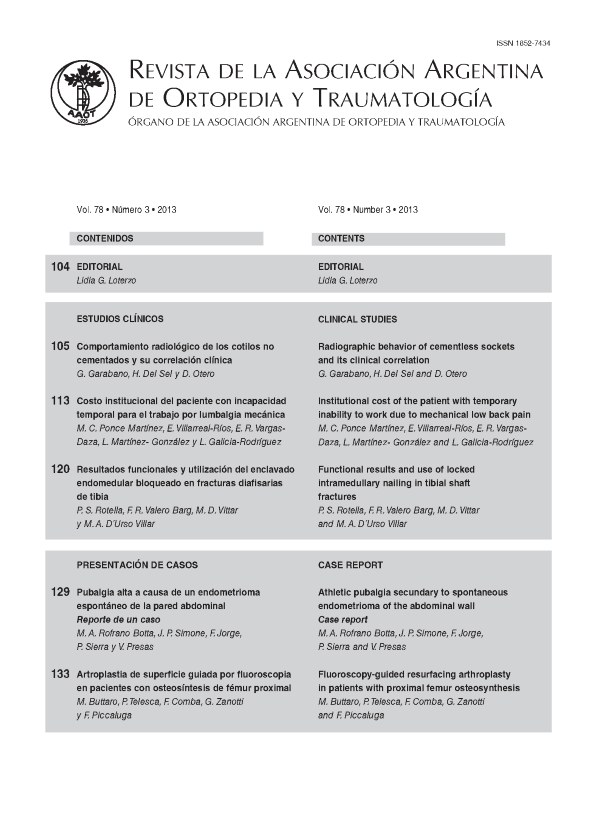Institutional cost of the patient with temporary inability to work due to mechanical low back pain
Main Article Content
Abstract
Downloads
Metrics
Article Details

This work is licensed under a Creative Commons Attribution-NonCommercial-ShareAlike 4.0 International License.
Manuscript acceptance by the Journal implies the simultaneous non-submission to any other journal or publishing house. The RAAOT is under the Licencia Creative Commnos Atribución-NoComercial-Compartir Obras Derivadas Igual 4.0 Internacional (CC-BY-NC.SA 4.0) (http://creativecommons.org/licences/by-nc-sa/4.0/deed.es). Articles can be shared, copied, distributed, modified, altered, transformed into a derivative work, executed and publicly communicated, provided a) the authors and the original publication (Journal, Publisher and URL) are mentioned, b) they are not used for commercial purposes, c) the same terms of the license are maintained.
In the event that the manuscript is approved for its next publication, the authors retain the copyright and will assign to the journal the rights of publication, edition, reproduction, distribution, exhibition and communication at a national and international level in the different databases. data, repositories and portals.
It is hereby stated that the mentioned manuscript has not been published and that it is not being printed in any other national or foreign journal.
The authors hereby accept the necessary modifications, suggested by the reviewers, in order to adapt the manuscript to the style and publication rules of this Journal.
References
2. Pérez J. Contribución al estudio de la lumbalgia inespecífica. Rev Cubana Ortop Traumatol 2006;20(2):1-25.
3. Duque I, Zuluaga D, Pinilla A. Prevalencia de lumbalgia y factores de riesgo en enfermeros y auxiliares de la ciudad de Manizales. Hacia la Promoción de la Salud 2011;16:27-38.
4. Araña-Suárez SM. Trastornos musculoesqueléticos, psicopatología y dolor. Programa Nacional de FIPROS 2009;(38).
5. Noriega-Elío M, Barrón A, Sierra O, Méndez I, Pulido M, Cruz C. La polémica sobre las lumbalgias y su relación con el trabajo: estudio retrospectivo en trabajadores con invalidez. Cad Saúde Pública 2005;21(3):887-97.
6. Instituto Mexicano del Seguro Social. Guía de práctica clínica diagnóstica, tratamiento y prevención de lumbalgia aguda y crónica en el primer nivel de atención 2008.
7. Ocaña U. Lumbalgia ocupacional y discapacidad laboral. Revista de Fisioterapia 2007;6(2):17-26.
8. Saldívar A, Cruz D, Serviere L, Vázquez F, Joffre V. Lumbalgia en trabajadores. Epidemiología. Rev Med IMSS 2003;41(3):203-9.
9. Hallne D, Hesembring M. Classification of psychosocial risk factors (yellow flags) for the development of chronic low back and leg pain using artificial neural network. Neuroscience Letters 2004;361(1-3):151-4.
10. Arcila-Herrera H. Patologías del sistema musculoesquelético. Rev Med CMA 2010;3:4-9.
11. Sánchez-Hernández M, Ibarra-Ramírez C, Vilchis-Aguado M, Montesano-Delfín J, Guízar-Mendoza J, Loya-García B. Impacto del servicio de rehabilitación en el primer nivel de atención. Rev Med Inst Mex Seguro Soc 2008;(4):391-6.
12. Airaksinen O, Brox JI, Cedraschi C, Hildebrandt J, Klaber-Moffett J, Kovacs F, et al. European guidelines for the management of chronic nonspecific low back pain. Eur Spine J 2006;15(Suppl 2):S192-300.
13. Boleaga B. Lumbalgia. Anales de Radiología México 2005;(2):89-97.
14. Romanó C, Romanó D, Lacerenza M. Antineuropathic and antinociceptive drugs combination in patients with chronic low back pain. A systematic review 2012; (2012), Article ID 154781, 8 pages. doi:10.1155/2012/154781. [Consulta: 20 de marzo de 2013].
15. Gilron I. Gabapentin and pregabalin for chronic neuropathic and early postsurgical pain: current evidence and future directions. Curr Opin Anaesthesiol 2007;20(5):456-72.
16. Young R, Benold T, Whitham J, Burge S. Factors influencing work interference in patients with chronic low back pain: a residency research network of texas. (RRNeT) Study 2011;(24):503-10. [Consulta: 10 de septiembre de 2012] Disponible en: http://www.jabfm.org/content/24/5/503.full.pdf.

